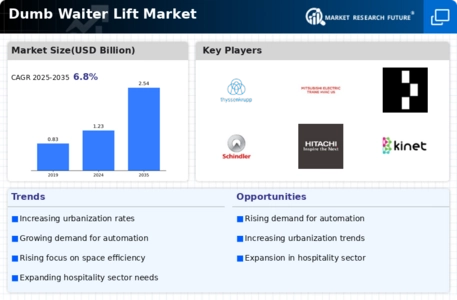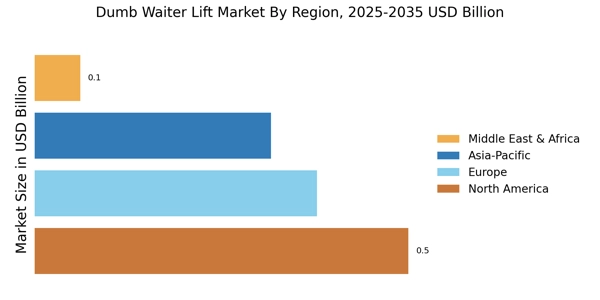Rising Focus on Health and Safety
Health and safety regulations are becoming increasingly stringent across various industries, including food service and healthcare. The Dumb Waiter Lift Market is benefiting from this trend as businesses seek to minimize manual handling and reduce the risk of workplace injuries. By utilizing dumb waiters, establishments can ensure safer transportation of goods, particularly in environments where hygiene is paramount. The market is likely to see growth as companies invest in these systems to comply with regulations and enhance employee safety. Furthermore, the integration of smart technology in dumb waiters may further bolster their appeal, as businesses look for innovative solutions to meet health and safety standards.
Expansion of Food Delivery Services
The rise of food delivery services has significantly impacted the demand for dumb waiter lifts, particularly in urban areas. As restaurants and food establishments adapt to changing consumer preferences, the need for efficient food transportation systems has become apparent. The Dumb Waiter Lift Market is experiencing growth as businesses seek to streamline their operations and improve service delivery. This trend is expected to continue, with the market projected to expand as more establishments recognize the benefits of integrating dumb waiters into their logistics. The convenience and efficiency offered by these systems align well with the fast-paced nature of the food delivery industry, suggesting a promising future for market players.
Increased Demand in Hospitality Sector
The hospitality sector has shown a marked increase in the adoption of dumb waiter lifts, driven by the need for efficient service delivery. Restaurants, hotels, and catering services are increasingly integrating these systems to streamline operations. The Dumb Waiter Lift Market is witnessing a surge in demand as establishments seek to enhance customer experience while optimizing staff efficiency. According to recent data, the market for dumb waiters in the hospitality sector is projected to grow at a compound annual growth rate of approximately 6% over the next five years. This trend indicates a robust potential for manufacturers and suppliers to cater to the evolving needs of this sector, thereby reinforcing the importance of innovation and reliability in product offerings.
Technological Innovations in Automation
Technological advancements are playing a crucial role in the evolution of the dumb waiter lift market. Automation features, such as remote control and smart integration, are becoming increasingly prevalent, enhancing the functionality and user experience of these systems. The Dumb Waiter Lift Market is witnessing a shift towards more sophisticated models that offer improved efficiency and ease of use. As automation technology continues to advance, manufacturers are likely to invest in research and development to create smarter, more reliable dumb waiters. This trend not only meets the demands of modern consumers but also positions companies to remain competitive in a rapidly changing market landscape.
Growing Urbanization and Space Constraints
Urbanization continues to reshape living and working environments, leading to increased space constraints in residential and commercial buildings. The Dumb Waiter Lift Market is responding to this challenge by providing solutions that maximize vertical space utilization. As more people move into densely populated areas, the demand for efficient material handling systems, such as dumb waiters, is likely to rise. This trend is particularly evident in multi-story buildings where traditional elevators may not be feasible. The market is expected to expand as architects and builders increasingly incorporate dumb waiters into their designs, recognizing their potential to enhance functionality without compromising space.


















Leave a Comment